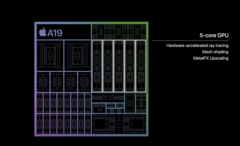Apple's newest smartphone SoCs are finally here. Like previous generations, they're segmented into regular and Pro variants, and this time, the differences between the two are more or less the same as previous generations. Both come with a six-core CPU (2P + 4E), a standard design found on Apple SoC's for years.
The regular A19 found on the iPhone 17 comes with a five-core GPU, while the A19 Pro has a six-core variant. To make matters even more puzzling, the A19 Pro found on the iPhone Air only comes with five GPU cores. The A19 Pro apparently uses a 'second-generation' GPU architecture to keep with all the Pro features offered by the iPhone 17 Pro and iPhone 17 Pro Max. Both GPUs support hardware-accelerated raytracing and MetalFX upscaling.Lastly, the A19 and A19 Pro come with Apple's new N1 wireless networking chip that enables Wi-Fi 7 and Bluetooth chip.
Performance-wise, the A19 doesn't appear to offer much of an upgrade over the A18. This is evidenced by the fact that Apple compares with the four-generation-old A15, claiming it is 1.5x faster on the CPU side and 2x faster on the GPU side. The A19 Pro's performance uplift is obscured further, with Apple stating it, "delivers up to 40 percent better sustained performance than the previous generation" without explicitly specifying which previous generation chip.
Both chips are manufactured on TSMC's third-generation 3 nm node, aka TSMC N3P. Given N3P offers a paltry 4% increase in transistor density over N3E, the performance delta between the A18 and A19 shouldn't be all that much. Ideally, this should give Qualcomm and MediaTek time to catch up with Apple, although that advantage might evapourate with the A20, which is tipped to use TSMC's next-gen Nanosheet-based N2 node.



















